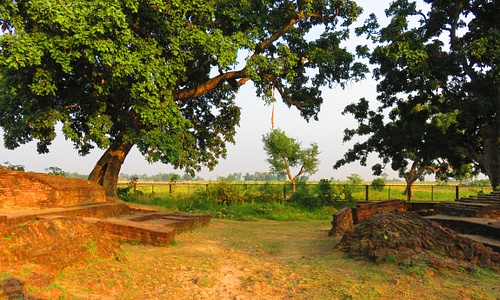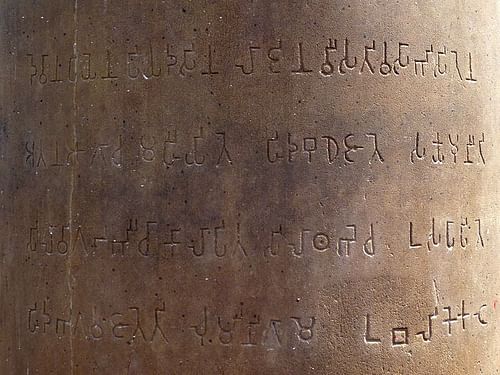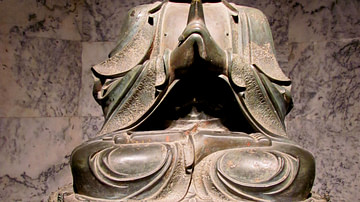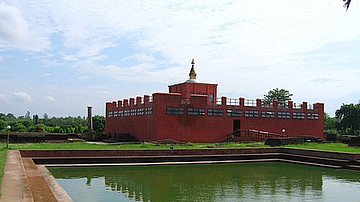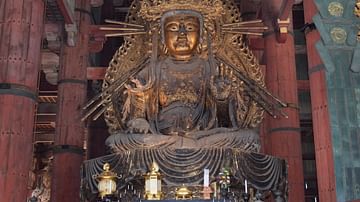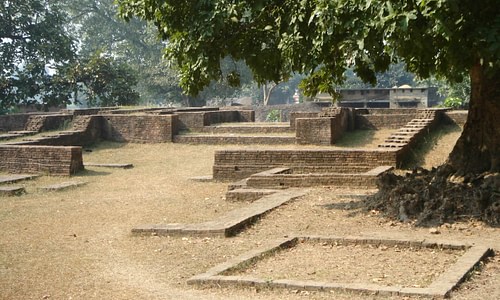
Kapilavastu (“Place of Kapila”) is the name of the city where Siddhartha Gautama (the Buddha, l. c. 563-483 BCE) grew up and lived for the first 29 years of his life before leaving to pursue the spiritual path which led to his enlightenment. The city is thought to have been named in honor of the sage Kapila.
Kapila was the founder of the Samkhya school of philosophy of India, believed by some scholars to have influenced the Buddha's own spiritual and intellectual development. It is possible Kapila founded the village as a philosophical center but this claim is speculative.
In the present day, Kapilavastu refers to a district in Nepal where the archaeological site of Tilaurakot is located (one of the claimants as ancient Kapilavastu) but is also used to refer to the village and archaeological site of Piprahwa in Uttar Pradesh, India, just across the border from Nepal (the other major contender as the ancient city). Both sites have provided significant evidence for their claims and recognition of which is the “real” Kapilavastu is based on which arguments one finds more convincing.
The ancient city was ruled by the oligarchy of the Shakya clan and maintained close ties to the nearby city of Devadaha, controlled by their relatives, the Koliya clan, both of which claimed descent from the legendary Ikshvaku Dynasty. According to Buddhist tradition, it was ruled at the time of Siddhartha's birth by his father, Suddhodana, who, after hearing a prophecy that his son would grow up to become either a great king or powerful spiritual leader, took measures to ensure Siddhartha would never experience the kind of suffering which might lead him to pursue the spiritual path and turned Kapilavastu into a vast pleasure compound to keep him distracted and ensure he would succeed to the throne. His plans would fail, however, after Siddhartha recognized the impermanence of existence and left the city to find his own path.
Kapilavastu was destroyed by the Kingdom of Kosala (c. 7th-5th centuries BCE), which had assumed control of the region, under their king Vidudabha (c. 6th century BCE) of the Baghochia Dynasty during the Buddha's lifetime. According to Buddhist tradition, Buddha is said to have wept upon hearing the news that his clan had been nearly annihilated and his city destroyed, an anecdote used to comfort modern Buddhists in their own times of grief and loss in that even the Buddha recognized the importance of mourning.
The sites of modern-day Piprahwa and Tilaurakot were both first excavated in the 1898-1899 CE season, the first by the British landowner William Claxton Peppe and the second by the Indian archaeologist Purna Chandra Mukherjee (also given as P.C. Mukherjee or Mukherji, l. c. 1845-1903 CE). Excavations have been ongoing periodically since that time, and today both sites are considered significant for the insights they provide on the life of the historical Buddha and his time although debate continues as to which was the ancient city.
Legendary History
Kapilavastu (according to Buddhist texts) was founded by the king Ikshvaku, one of the sons of the mythical Shraddhadeva Manu, the first human. Shraddhadeva Manu, according to Hindu texts, assisted a small fish in a river who, revealing himself as the god Vishnu, warned him of the impending Great Flood, which was coming to destroy humanity. Shraddhadeva Manu built a great boat for his family, seeds of all plants, two of each kind of animal, and the seven patriarchs (saptarishi) and rode out the flood; afterwards, his family and the patriarchs repopulated and replanted the earth.
Ikshvaku, continuing his father's legacy of compassion and care, initiated building projects to house and protect his people; one of these cities is said to have been Kapilavastu. Whatever the city's original name may have been is unknown (if there even was an original name), but Kapilavastu means the “place of Kapila” and references a great sage who lived at least 100 years before the Buddha and whose philosophy (Samkhya) was honored by the Shakya clan and would later (according to some schools of thought) directly influence the development of Buddha's vision.
Ikshvaku is identified with the Shakya king Okkaka, the first chief of the Shakya and, possibly, their nearby relatives, the Koliya. At least 20 years before the Buddha's birth, Kapilavastu was ruled by the Shakya chief (or king), Sihahanu while the nearby city of Devadaha was ruled by his brother Anjana. The two cities were allied closely through intermarriage in order to keep the bloodline pure, and this tradition continued with the marriage of Suddhodana, son of Sihahanu of the Shakya, to Maya, daughter of Anjana of the Koliya, which would result in the birth of the Buddha.
Kapilavastu & the Buddha Legend
According to the biography of Siddhartha Gautama from the early Buddhis texts, Suddhodana of Kapilvastu and Maya of Devadaha were prince and princess (later king and queen) while Kapilavastu itself is sometimes referenced as a kingdom or royal city. For the first 20 years of their marriage, they had no children, but then, one night, Maya experienced a vivid dream in which four divine spirits carried her away to a garden where they bathed, anointed, dressed her in white, and bestowed garlands of flowers upon her. A white elephant appeared then in the dream and circled her three times before entering her womb through the right side. Maya awoke the next morning knowing she was pregnant.
As her time to deliver drew closer, in keeping with tradition, she assembled an entourage and set out for her home city of Devadaha. The group stopped at the gardens of Lumbini, located between the two cities and, perhaps, landscaped and cared for by both, so she could bathe and rest. After her bath, Maya stepped from the pond and went into labor, giving birth to her son beneath a Sala tree whose branch she clung to for support. The newborn is said to have stood up as soon as he was born, took seven steps, and announced his arrival as a bringer of peace.
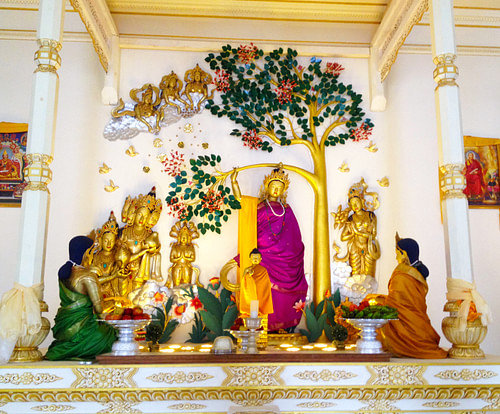
Afterwards, the entourage, seemingly, returned to Kapilavastu where a sage predicted that the young prince would grow up to become a mighty king or great spiritual leader. Seven days after his birth, Maya died and his father, fearing that exposure to this kind of suffering – or any kind – would inspire his son to pursue spirituality instead of politics, decreed that he should never know such pain and took measures to prevent it, quickly marrying Maya's sister, Prajapati, so that his son would have a mother.
Depending on which version of the legend one reads, Suddhodana's plan took the form of surrounding young Siddhartha with luxurious diversions, keeping him constantly occupied with study and pleasures, surrounding his palace with a pleasure compound of a high wall, or all of the above. Siddhartha spent the first 29 years of his life in this paradise, married, and had a son before he was exposed to the suffering of life through the Four Signs – an aged man, a sick man, a dead man, and a spiritual ascetic – when he was out for a ride beyond the walls of Kapilavastu.
The realization that he had been living in a dream world of his father's making, and that he, too, would one day experience sickness, old age, and death made all of his former life intolerable to him. Everything he loved, he realized, would one day be lost and everything he had believed to be true was an illusion. He renounced his position and left Kapilavastu, embracing the path of the spiritual ascetic, until he eventually attained enlightenment and became the Buddha (“the awakened one”). Afterwards, he spent the next 45 years of his life teaching others the means by which they could liberate themselves from illusion and suffering in order to live in peace.
The Legend & the History
Modern scholarship casts serious doubt on the historicity of the traditional legend, first of all, because it does not seem that Suddhodana was a king nor that Maya was a princess or queen. Archaeological evidence and non-Buddhist texts suggest that the Shakya political organization was an oligarchy in which rulers were elected. Suddhodana was, therefore, probably more or a regional governor than a monarch. Further supporting this view is the fact that Kapilavastu was under the control of the Kingdom of Kosala (either at this time or not long after) and would have appointed such governors to control different territorial regions. Scholar John Keay comments:
The Shakya state [was one of those republics which had many governors]. And since their chief was elected, the 'Prince' Siddhartha of later legend must be considered a fabrication. Moreover, Kapilavastu, the Shakya capital, was not a major political center…Trade and craftsmanship were more the Buddha's milieu than royal ceremonial. [Even so] the affluence against which he eventually reacted by renouncing his wife and family to begin an enquiry into the human condition may have been real; equally, it may have been the perceived luxury of more celebrated urban centers. (64)
However that may be, once a legend or myth is accepted as history, there is little hope of changing it. The story of Siddhartha's early life and renunciation has long been accepted – if not as history – then at least as probable or possible on various levels of interpretation. The question which continues to divide scholars and laypersons alike in the modern day – regarding the sites associated with the historical Buddha at least - is not Siddhartha's early standing, nor even Kapilavastu's, but where that ancient city, which figures so prominently in the story, was located.

Tilaurakot or Piprahwa
The Early Buddhist texts, including the Tripitaka (Buddha's teachings, regarded as scripture), provide some information on Siddhartha Gautama's life but nothing on where the important sites of his life were located. Modern-day archaeologists, therefore, relied on three sources to identify Kapilavastu:
- The site of the garden of Lumbini
- The work of the Chinese pilgrim Faxian
- The work of the Chinese pilgrim Xuanzang
Before dying, the Buddha suggested to his disciples that important sites associated with his life be honored so that his followers could make pilgrimage and commune there. These were:
- Lumbini – his place of birth
- Bodh Gaya – where he attained enlightenment
- Sarnath – where he gave his first sermon
- Kushinagar – where he died
His disciples honored his wishes and erected a stupa at each of these sites (among others) which held a portion of the Buddha's relics. His teachings were then preserved by his followers, eventually branching into different schools, but Buddhism did not attract as many followers as the two other major belief systems of the time, Hinduism and Jainism, until the reign of Ashoka the Great (268-232 BCE). After Ashoka converted to Buddhism, he went on pilgrimage, erecting pillars at various sites, and among these was Lumbini. In 249 BCE, he placed a pillar at the site declaring it the Buddha's birthplace and establishing its name. He also sent missionaries to other countries to spread the Buddha's message and, in time, pilgrims came from countries such as Sri Lanka and China, among others, to visit the sites.
Two of these were Faxian (l. 337 - c. 422 CE) and Xuanzang (l. 602-664 CE) who wrote of their travels in A Record of the Buddhistic Kingdoms and Buddhist Records of the Western World, respectively. Both visited the sites of Lumbini and Kapilavastu, and both give detailed descriptions. In the 19th century CE, when archaeologists were looking for the site of Kapilavastu, they found Lumbini in 1896 CE.
Using the texts of Faxian and Xuanzang, all it seemed they had to do was follow in their footsteps to locate Kapilavastu. The problem was that, while Lumbini was being excavated, two other sites were identified as Kapilavastu, both of them – more or less – fitting the description of the Chinese pilgrims.
Rediscovery & Controversy
Lumbini had been identified by former military commander and then-regional governor Khada Shamsher Jang Bahadur Rana (served in office 1885-1887 CE) in 1896 CE, who heard of the discovery of an ancient pillar in the jungle (Ashoka's pillar), sent workmen to unearth it, and reported the find to the Irish Indologist Vincent Arthur Smith (l. 1843-1920), who was serving in an administrative position for the British in the area. Smith contacted Sir Alexander Cunningham (l. 1814-1893 CE), founder of the Archaeological Survey of India, which was in charge of excavations, historical preservation, and overseeing the work of various archaeologists in the region.
Among these was the German archaeologist Alois Anton Fuhrer (l. 1853-1930 CE) who was trying to locate Kapilavastu. When he heard of the discovery of the pillar, Fuhrer hurried to the site of Lumbini and then filed reports claiming to have discovered it (a claim, unfortunately, repeated by historians afterwards and up to the present day), leaving off his – thus far – futile efforts in finding Kapilavastu. Fuhrer excavated a number of areas at Lumbini and then falsified documents and, further, forged antiquities he claimed to have found there and sold them on the open market. He was formally charged by Vincent Arthur Smith, stripped of his position, and left the country.
Locating Kapilavastu then fell to the Indian archaeologist Purna Chandra Mukherjee who, because of the racial beliefs of his white European colleagues, had been repeatedly passed over for the honor of leading an expedition. Mukherjee finished excavating Lumbini and then, following his own earlier research and the works of Faxian and Xuanzang, located what seemed to be Kapilavastu a short distance away at Tilaurakot in 1898 CE.
At about the same time, a British landowner named William Claxton Peppe was clearing land at his estate in India near the village of Piprahwa and excavated a large mound of earth from which emerged a brick stupa. At a depth of 18 feet, he found a stone coffer containing jewels, bone fragments, ashes, and five small vases, one of which was inscribed with a line, in Brahmi script, claiming to hold the remains of the Buddha. This inscription was challenged, however, not only because – at first – it was thought to refer to the Buddha's relatives, but due to Fuhrer's recent flurry of forged artifacts. The inscription was authenticated, however, by the highly respected French orientalist Auguste Barth (l. 1834-1916 CE), and the vase acknowledged as containing the Buddha's remains. This find, along with the age and construction of the stupa and other artifacts on site, strongly suggested that Piprahwa was ancient Kapilavastu.
At Tilaurakot, meanwhile, Mukherjee excavated a number of structures and unearthed sculptures relating to the Buddha, terracotta figurines, pottery shards, beads, coins, the ruins of what appeared to have been a fort, living quarters, and a monastic structure, as well as two stupas associated with Suddhodana and Maya. He submitted the reports on his work to the proper authorities, claiming to have identified Kapilavastu, but Auguste Barth was not impressed, and his opinion carried more weight than Mukherjee's. Tilaurakot was not dismissed as the site of Kapilavastu but, owing to the finds at Piprahwa, was not confirmed.
Conclusion
Since that time, the debate has continued over which site is the “real” Kapilavastu. Those who favor Tilaurakot claim that it is closer to Lumbini than Piprahwa and on a more or less direct route to the site of Bhawanipur, identified as the ancient Devadaha. It, therefore, fits well with the narratives of Faxian and Xuanzang, contains stupas associated with the Buddha's parents, was obviously once an important pilgrimage site based on the artifacts discovered there and, further, has the ruins which suggest it was at one point a Buddhist religious center. This last point is important in that, according to legend, the Buddha returned to Kapilavastu after he had established a following and converted a number of family members to his vision. Among these was his aunt-mother Prajapati who established the first order of Buddhist nuns and, most likely, at Kapilavastu.
Tilaurakot is also claimed to be the better candidate for Kapilavastu because the Buddha did not include the city in his suggestions of places of pilgrimage and so, of course, there would be no stupa there and no relics. Those who support Piprahwa as Kapilavastu, however, claim that it is actually closer to Lumbini and fits better with the narrative of the Buddhist texts and the works of Faxian and Xuanzang and, further, point to the stupa, stone coffer and, especially, the vase containing the Buddha's remains found there as proof of the site's authenticity.
The argument is compelling in that excavations of the stupa show that it was built in three phases, the middle phase from the time of the reign of Ashoka the Great, and this fits with a well-known narrative. At the same time that Ashoka was sending out his missionaries, he had the Buddha's remains disinterred from the eight (or ten) stupas erected by Buddha's first disciples and then reinterred in 84,000 other stupas throughout his kingdom. The stupa at Piprahwa certainly fits with this narrative of Ashoka erecting stupas in many other locales than the original sites, and since in 249 BCE Ashoka had been on a pilgrimage to sites associated with the Buddha's life, he would have visited Kapilavastu and had a stupa with the Buddha's remains erected there.
Both sides of the argument offer compelling reasons for accepting Tilaurakot or Piprahwa as Kapilavastu and both sites have much to recommend them as the ancient city. Excavations are ongoing and it is entirely possible that new evidence will appear to tip the scales in one direction or another. At the present, however, it is up to each individual with an interest in the subject to weigh the extant evidence and decide for themselves.
